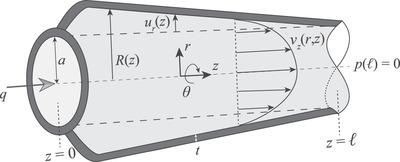Our official English website, www.x-mol.net, welcomes your
feedback! (Note: you will need to create a separate account there.)
Revisiting steady viscous flow of a generalized Newtonian fluid through a slender elastic tube using shell theory
ZAMM - Journal of Applied Mathematics and Mechanics ( IF 2.3 ) Pub Date : 2020-08-02 , DOI: 10.1002/zamm.201900309 Vishal Anand 1 , Ivan C. Christov 1
ZAMM - Journal of Applied Mathematics and Mechanics ( IF 2.3 ) Pub Date : 2020-08-02 , DOI: 10.1002/zamm.201900309 Vishal Anand 1 , Ivan C. Christov 1
Affiliation

|
A flow vessel with an elastic wall can deform significantly due to viscous fluid flow within it, even at vanishing Reynolds number (no fluid inertia). Deformation leads to an enhancement of throughput due to the change in cross‐sectional area. The latter gives rise to a non‐constant pressure gradient in the flow‐wise direction and, hence, to a nonlinear flow rate–pressure drop relation (unlike the Hagen–Poiseuille law for a rigid tube). Many biofluids are non‐Newtonian, and are well approximated by generalized Newtonian (say, power‐law) rheological models. Consequently, we analyze the problem of steady low Reynolds number flow of a generalized Newtonian fluid through a slender elastic tube by coupling fluid lubrication theory to a structural problem posed in terms of Donnell shell theory. A perturbative approach (in the slenderness parameter) yields analytical solutions for both the flow and the deformation. Using matched asymptotics, we obtain a uniformly valid solution for the tube's radial displacement, which features both a boundary layer and a corner layer caused by localized bending near the clamped ends. In doing so, we obtain a “generalized Hagen–Poiseuille law” for soft microtubes. We benchmark the mathematical predictions against three‐dimensional two‐way coupled direct numerical simulations (DNS) of flow and deformation performed using the commercial computational engineering platform by ANSYS. The simulations show good agreement and establish the range of validity of the theory. Finally, we discuss the implications of the theory on the problem of the flow‐induced deformation of a blood vessel, which is featured in some textbooks.
中文翻译:

利用壳理论重新研究广义牛顿流体通过细长弹性管的稳定粘性流
即使在雷诺数消失(无流体惯性)的情况下,带有弹性壁的流量容器也会由于其中的粘性流体流动而显着变形。由于横截面积的变化,变形导致吞吐量的提高。后者在流动方向上产生了非恒定的压力梯度,因此产生了非线性的流速-压降关系(与刚性管的哈根-泊苏伊定律不同)。许多生物流体是非牛顿流体,并且可以通过广义牛顿(例如幂律)流变模型很好地近似。因此,我们通过将流体润滑理论与由Donnell壳理论提出的结构问题耦合,分析了广义牛顿流体通过细长弹性管的稳定低雷诺数流动问题。摄动方法(在细长参数中)为流动和变形提供解析解。使用匹配的渐近线,我们获得了管子径向位移的统一有效解决方案,该函数具有边界层和拐角层,这些边界层和拐角层都是由受夹紧端附近的局部弯曲引起的。这样,我们就获得了适用于软微管的“广义哈根-泊瓦依定律”。我们使用ANSYS使用商业计算工程平台执行的流动和变形的三维双向耦合直接数值模拟(DNS),对数学预测进行基准测试。仿真显示出良好的一致性,并建立了理论的有效性范围。最后,我们讨论了该理论对血管流动引起的变形问题的影响,
更新日期:2020-08-02
中文翻译:

利用壳理论重新研究广义牛顿流体通过细长弹性管的稳定粘性流
即使在雷诺数消失(无流体惯性)的情况下,带有弹性壁的流量容器也会由于其中的粘性流体流动而显着变形。由于横截面积的变化,变形导致吞吐量的提高。后者在流动方向上产生了非恒定的压力梯度,因此产生了非线性的流速-压降关系(与刚性管的哈根-泊苏伊定律不同)。许多生物流体是非牛顿流体,并且可以通过广义牛顿(例如幂律)流变模型很好地近似。因此,我们通过将流体润滑理论与由Donnell壳理论提出的结构问题耦合,分析了广义牛顿流体通过细长弹性管的稳定低雷诺数流动问题。摄动方法(在细长参数中)为流动和变形提供解析解。使用匹配的渐近线,我们获得了管子径向位移的统一有效解决方案,该函数具有边界层和拐角层,这些边界层和拐角层都是由受夹紧端附近的局部弯曲引起的。这样,我们就获得了适用于软微管的“广义哈根-泊瓦依定律”。我们使用ANSYS使用商业计算工程平台执行的流动和变形的三维双向耦合直接数值模拟(DNS),对数学预测进行基准测试。仿真显示出良好的一致性,并建立了理论的有效性范围。最后,我们讨论了该理论对血管流动引起的变形问题的影响,











































 京公网安备 11010802027423号
京公网安备 11010802027423号